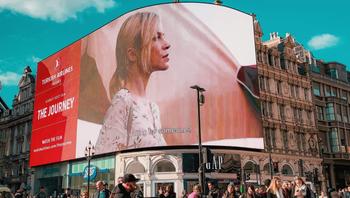October is Canadian small business month, and this year, it seems to have an even more profound meaning.
It’s no secret that along with the usual challenges small businesses face, 2020 has thrown business owners even more unforeseen curveballs. With this in mind, being strategic with budgets, in particular marketing budgets, is crucial.
If you’re looking to boost your sales, book more appointments, increase your online presence, or have any other marketing goal, you should give digital out-of-home a try.
Digital out-of-home is affordable
Historically, out-of-home campaigns were reserved for big companies with deep pockets. With the manual labour required by out-of-home companies to negotiate, prepare and schedule OOH campaigns, smaller businesses were often overlooked.
Now, with automated and self-serve buying platforms, the manual labour required for publishers to schedule a campaign is removed, giving small businesses their time to shine.
The digitization of OOH also added another benefit: the ability to buy only on select screens at select times. Gone are the days where you needed to buy a four-week billboard campaign.
Instead, you can pick and choose the screens that will have the most impact on your business, and only spend when the time is right.
Put yourself in the shoes of a brunch restaurant owner with a fairly small marketing budget.
To make the most bang for their buck, they could only choose screens within a 3KM radius of their restaurant. They could also advertise only during times that their restaurant is less busy, like weekdays or only between 7AM and 10AM on weekend.
Digital out-of-home is targeted
There’s a misconception that digital out-of-home is a faceless channel, not truly knowing who’s seeing the ads. While we may not know the individuals in front of the screens, data actually tells us a lot about the audience each screen reaches.
The most common way screen owners collect data is by partnering with mobile data companies. They provide anonymized demographic data like age, gender, interests, life stage and more.
Booking a DOOH is actually quite similar to how you would book one on social media. Rather than manually selecting your desired screens, you instead identify your desired audience. The platform then analyzes the screen inventory and selects the right screens for your campaign.
Unlike our restaurant example, whose service is highly linked to location, this is a great option for online businesses or those in more niche markets.
A new mobile phone game might be ideal for gamers and young adults. The system would then find screens around which this audience is located. It might be on campuses during the school week, or by city parks on the weekend.
Digital out-of-home is creative
Digital out-of-home screens are bright, eye-catching and are central to people’s days outside the home. As much as they could try, people can’t help but notice the ads on Time Square.
Yes, these are the world’s most famous screens, but there’s more to it: the marketing agencies that build campaigns for locations like these put a lot of thought into the creatives.
As a small business, you might not have the resources to pay a prestigious NYC advertising agency, so here are the secrets to making a great DOOH creative:
- Use impactful colours & good contrast
- Keep words to a minimum
- Make your offer clear & concise
- Have a clear call to action
- Have fun with it
Besides being a beautiful, bold marketing channel, the data behind DOOH can push your creativity even further.
The brunch restaurant might consider building a ‘meal of the day’ campaign and showcase a different menu item every day of the week. This not only keeps their creatives fresh but is a great incentive for customers to swing by more than once.
Digital out-of-home is flexible
Another great aspect of digital out-of-home is that campaigns can be as flexible as your business. Other than the budget and creative flexibility we mentioned earlier, there is overall campaign flexibility with DOOH that was not possible a few years ago.
When booking a DOOH campaign, you aren’t signing your marketing budget away. Instead, you’re investing in a medium that can keep up with the ebbs and flows your business goes through.
Take a local handmade furniture shop. Sometimes, sales might be great and you’re scrambling to keep up with orders. Great, pause your campaign! Maybe your signature maple wood is on backorder. No problem, change your campaign to display your mahogany models! Suddenly have overstock of one item, promote that!
With DOOH, you can start, pause or adjust your campaign in minutes, giving you full control of your campaign delivery.
We actually ran a very last-minute campaign after having a wild idea to advertise to people participating in Montreal’s Climate March. Check out how we pulled it together in a matter of hours:
Digital out-of-home is powerful
All forms of advertising have their strengths and weaknesses, but digital out-of-home is a particularly powerful tool.
When compared to online, DOOH doesn’t need to deal with some common challenges like ad blockers or ad blindness. DOOH ads are also perceived as more reliable and are generally less invasive on a person’s experience. A DOOH ad doesn’t make you wait to watch your favourite YouTuber’s most recent video, after all.
Now let’s compare to social. While these channels claim to know a person’s interest, liking a specific page doesn’t necessarily mean a person is actually in the market for a related item. Someone who follows many cat accounts on Instagram might not own a cat, but someone in the pet food aisle at the grocery store is much more likely to!
We aren’t necessarily saying to stop marketing on these channels – if you have something good going for your business, keep it up! DOOH is shown to be a strong complement to other channels and only adds to the reach and frequency of your campaign.





